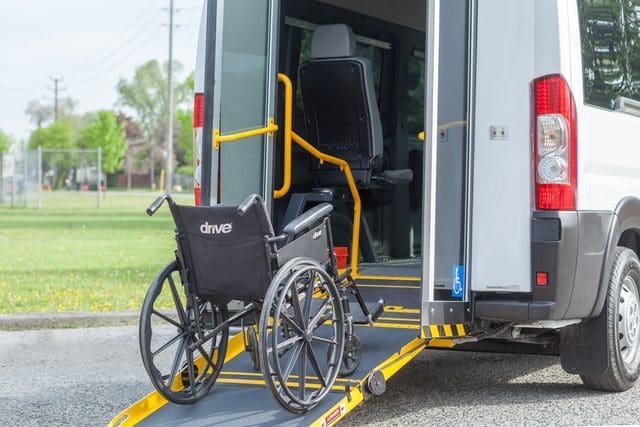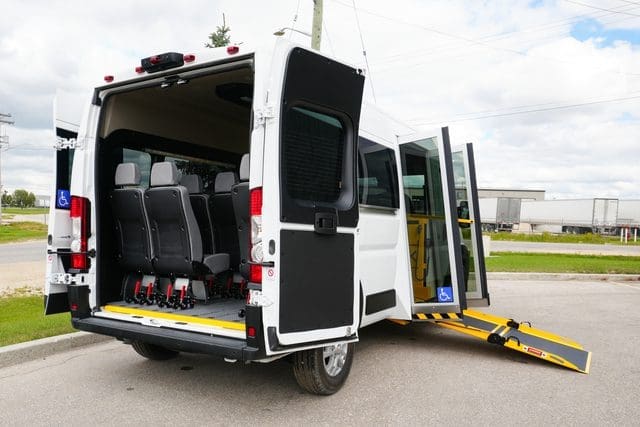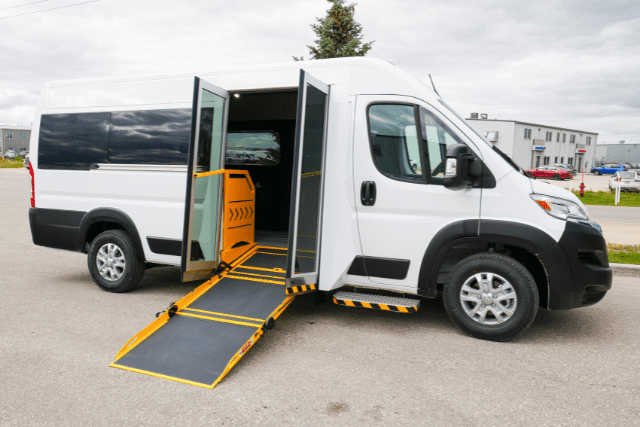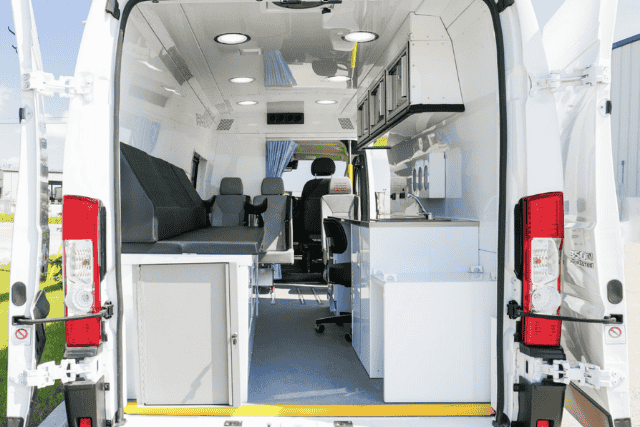Ever feel a little stuck looking at an unused wheelchair van in your parking lot? Maybe it served its purpose for a time, but now your needs have changed. The van’s still in good condition, but it isn’t being used anymore. That’s frustrating, especially when you think about how much planning and funding went into getting it in the first place.
And you’re probably wondering, now what? Letting it sit doesn’t feel right. Vehicles don’t do well when they sit for long. Maintenance issues can creep in, budgets tighten, and program leaders may question how to best use resources. You want to make the most of what you have. And maybe, just maybe, you’re also hoping that van could still help someone.
At MoveMobility, we’ve been building accessible vehicles for over 20 years. Our team works with healthcare networks, non-profits, and community groups across Canada. We hold Ford QVM and Stellantis QPro certifications, and every van we build carries the National Safety Mark. We design vehicles that solve real challenges. But we also know we’re not the only ones out there. That’s why this article gives you clear, unbiased options to help you move forward.
Here’s what you’ll learn:
- 5 options for what to do with an unused wheelchair van
- How to take the next step confidently
Why is your wheelchair van not getting as much use anymore?
If your wheelchair van isn’t hitting the road much these days, you’re probably asking yourself why. The answer is rarely just one thing. Often, it’s a mix of practical challenges and shifting priorities.
Program changes: Maybe the program the van supported has scaled back, or funding has shifted to other areas. It happens, especially in community organizations where needs can change quickly.
Maintenance concerns: A wheelchair van that isn’t being used might be due for repairs that never quite make it to the top of the list. A sticky ramp, worn brakes, or air conditioning issues can make the vehicle less reliable, so it stays parked.
Driver availability: You can have the perfect vehicle, but without trained drivers, it’s tough to keep it on the road. Volunteer shortages or staffing changes can bring regular trips to a halt.
New transportation options: Sometimes your community finds a different solution. A local transit partnership or shared service might reduce the need for your van.
Here’s the good news: Understanding the “why” is the first step to deciding what to do next. Once you know what’s keeping your wheelchair van parked, you can decide whether it’s time to bring it back into service, pass it along, or take another route entirely.
Next, let’s look at some smart options for putting an unused wheelchair accessible van back to work.
5 options for what to do with an unused wheelchair van

An unused wheelchair van doesn’t have to be a problem collecting dust in your lot. In fact, it can be a chance to create value in a new way. Across Canada, organizations have found creative, practical ways to put these vehicles back into service, help more people, or recover some of their investment.
We’ll walk through five actionable options. Each one can help you move from “idle” to “impact.” Let’s start with the first.
1. Repurpose your unused wheelchair van for another program
Sometimes the simplest option is right in front of you. If the wheelchair van that isn’t being used doesn’t fit its original role, it might fit somewhere else in your organization.
- Look at your current needs: Are there other departments or programs that could use accessible transportation? For example, if your health outreach program in Winnipeg no longer needs the van daily, maybe your community recreation program could use it to transport members to events.
- Consider seasonal or event-based use: In many regions of Canada, programs change with the seasons. A van not needed in winter might be perfect for summer day programs, cultural events, or outreach clinics.
- Think beyond your walls: Could another branch of your organization, or a partner group you work closely with, benefit from it? This can strengthen relationships while keeping the van in meaningful use.
Repurposing is a way to maximize a resource you already have. The van’s already paid for, insured, and accessible. Putting it to work in a different program can save time and money compared to starting from scratch.
Next, let’s explore what happens if repurposing isn’t the right fit, like donating or selling your unused wheelchair accessible van to someone who needs it.
2. Donate or sell your unused wheelchair van
If your unused wheelchair van isn’t the right fit for your programs anymore, it might still be perfect for someone else. Donating or selling the van can extend its life and create impact far beyond your organization.
- Donation: Many Canadian non-profits, community centers, and care facilities can’t afford a new wheelchair accessible van. A donation can make a life-changing difference. For example, organizations like Charity Village connect non-profits with resources that improve accessibility. Not only does this help another group, but it can also strengthen your community partnerships and demonstrate your organization’s commitment to inclusion.
- Selling: If a donation isn’t feasible, selling the van is another practical option. Platforms like the Government of Canada Surplus or provincial auction sites in Ontario, Alberta, or British Columbia can connect you with buyers. You might also work directly with another non-profit or community service provider who’s looking for an affordable vehicle.
- Tax or funding considerations: In some cases, donations may qualify for tax credits. If your organization is a registered charity, this can be an added benefit.
Donating or selling an unused wheelchair accessible van can turn an idle asset into a valuable resource for someone else. It also keeps the vehicle in use, serving the purpose it was built for: Providing safe, dignified transportation for people who need it.
If donating or selling isn’t the right fit, there’s another route that can work well: trading your unused wheelchair van for something that better meets your current needs.
3. Trade in your unused wheelchair van for a better fit
Sometimes the issue isn’t that your wheelchair van isn’t useful. It’s that it isn’t the right fit anymore. If your programs have changed, trading your unused wheelchair van can be a smart move.
- Evolving program needs: Maybe your current van was designed for frequent group trips, but now your services focus on individual transportation. Or maybe you need more storage space for equipment. In these cases, trading for a different model can save you from trying to make the wrong vehicle work.
- Upgrading for efficiency: Newer models can offer better fuel efficiency, upgraded accessibility features, and improved comfort. This is especially valuable for organizations covering large service areas, such as rural Manitoba or northern Alberta, where long drives are common.
- Partnering with the right dealer: Many dealerships and mobility vehicle manufacturers in Canada, including those specializing in accessible vans, accept trade-ins. The value from your unused wheelchair accessible van can be applied toward a vehicle that matches your current operations more closely.
Trading in isn’t just about replacing a vehicle. It’s about aligning your transportation tools with your current mission. The right van can reduce downtime, improve rider experience, and even help lower long-term maintenance costs.
If a trade still doesn’t match your plans, there’s another way to keep the van active while offsetting costs: Leasing it out to other organizations.
4. Lease out your unused wheelchair van
If your unused wheelchair van isn’t needed every day, leasing it out can be a smart way to keep it moving and generate income at the same time.
- Why does leasing work? Many community groups, schools, and care facilities need accessible transportation but don’t have the budget to purchase a van outright. Leasing gives them access when they need it, and your organization benefits from offsetting some of your costs.
- How to get started: Start by checking local interest. In cities like Calgary, Winnipeg, or Halifax, there are often non-profits or event organizers who only need an accessible van for short-term programs. You can also connect with regional vehicle leasing networks or list it on community boards that focus on accessibility.
- What to keep in mind: Leasing does require planning. You’ll want to set clear terms for maintenance, insurance, and driver qualifications. This protects both your organization and the people using the van.
Leasing out an unused wheelchair accessible van is a win for everyone. The van stays in use, you create value from an underused asset, and another group gains access to much-needed transportation.
If leasing isn’t the right path for your organization, there’s one more option that might make sense. Let’s talk about responsibly retiring or recycling a wheelchair van that isn’t being used anymore.
5. Retire or recycle your unused wheelchair van
Sometimes an unused wheelchair van has simply reached the end of its service life. Maybe it has high mileage, costly repairs, or safety concerns that make it hard to keep on the road. In these cases, retiring or recycling the van can be the most responsible choice.
- Evaluate its condition: Start by getting a mechanic’s assessment. If repairs cost more than the van’s value, it might be time to take it off active duty.
- Explore recycling options: Across Canada, there are programs that responsibly recycle vehicles. Services like Retire Your Ride can help remove older vehicles from the road while recycling parts and materials. Some programs even offer small incentives or donations to charities in your name.
- Consider parts value: Even if the van can’t run anymore, certain components may still have value. Mobility equipment like ramps or lifts can sometimes be salvaged or repurposed.
Retiring a wheelchair van that isn’t being used doesn’t mean its story ends. Recycling it properly prevents environmental impact and creates room in your fleet for vehicles that better match your current needs.
Now that we’ve covered five options for an unused wheelchair accessible van, you might be wondering which option you should choose. You’ll learn more about that in the next section.
Which option should you choose?
You’ve got five solid paths for your unused wheelchair van. But how do you know which one is right for your organization? It comes down to matching your goals, resources, and community needs.
Start with your priorities:
- Maximize impact: If helping more people is your main goal, consider repurposing or donating the van.
- Recover value: If you need to offset costs, selling, trading, or leasing can bring in funds or credits.
- Reduce liability: If the van’s condition is a concern, retiring or recycling may be the safest route.
- Look at your timelines: Do you need a quick resolution, or can the process take a few months? Leasing or trading may take longer to set up. Donation or recycling can often happen faster.
- Think about long-term needs: Is this a short-term gap, or has your transportation model shifted for good? If your needs have permanently changed, trading or selling might set you up for the future.
Choosing the right option is about balance. There’s no one-size-fits-all answer. The best choice is the one that keeps your resources aligned with your mission and keeps your community moving forward.
Ready to give your unused wheelchair van a new purpose?

You landed here because your wheelchair van isn’t being used, and that’s created some uncertainty. You’ve got a vehicle that once filled a need, but now it sits idle while your priorities or programs shift around it.
Now you’ve got options:
- Repurpose it for another program in your organization
- Donate or sell it to someone who can put it to use
- Trade it in for a model that fits your current goals
- Lease it out to recoup some of your investment
- Retire or recycle it if it’s reached the end of its journey
At MoveMobility, we work with you to solve real transportation problems. From small-town nonprofits to provincial health authorities, we’ve supported hundreds of teams as they navigate what’s next. Our job is to listen, guide, and help you take the next step that’s right for your community. If you’re ready to talk it through, click the button below to chat with one of our mobility experts. We’re here when you’re ready.
Not ready to talk to someone just yet? No problem. Here are three articles to help you learn more and move closer to the right decision:
- Repairing vs. replacing your wheelchair van: This one is helpful if you’re still deciding whether to hold onto your current van or move on from it.
- Best ways to sell your old wheelchair van: This is the perfect follow-up read if you’re leaning toward selling and want practical next steps.
- How to get more funding for your wheelchair van: This is great if you’re exploring new options and want to understand how to stretch your budget further.





